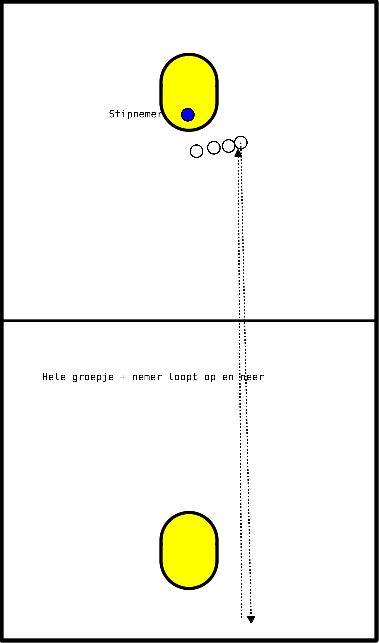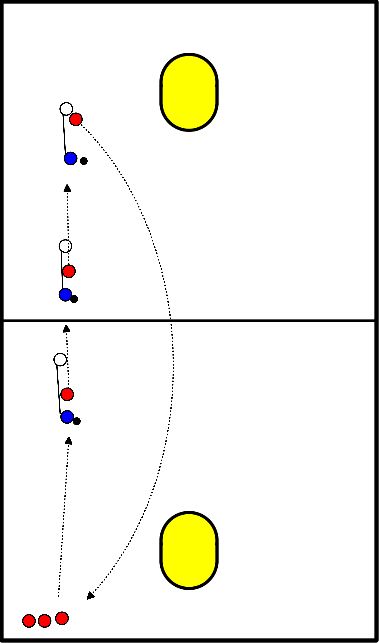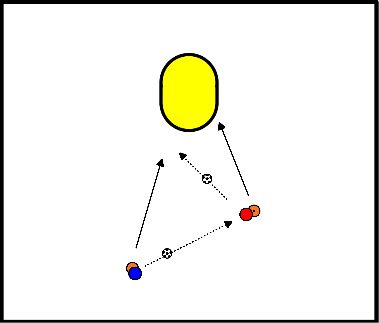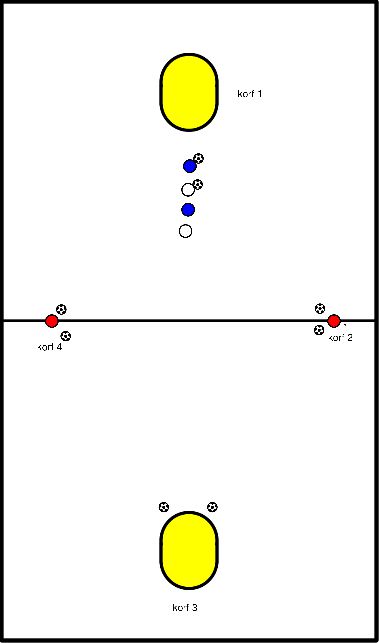Korfball drills
- Per person, everyone must score 10 through balls, this goes in groups of 3 or 4.
- In case of a miss, the whole group goes to the other side of the field on pace run and back.
- The one who missed takes the chance again.
- Until 10 are scored per player.

- For the example, I assume 6 / 7 players.
- On a line the length of the field there are 3 poles spaced about 7 meters apart.
- At each pole stands 1 player with ball.
- First the remaining players walk past all the posts and take a through ball everywhere.
- Repeat this 3 times and then switch positions.
- The next round are dodge balls to the left.
- The next round dodge balls to the right.

Objective:
The base is a standard running form exercise, where you have players move back and forth in different ways to train general motor skills.
The tap game element adds responsiveness by having players react as quickly as possible and determine what they are going to do.
The tap game element adds responsiveness by having players react as quickly as possible and determine what they are going to do.
Description:
- The players stand on a line and are given a way by the trainer to run across each time, see also running forms.
- All players have a ribbon on, 1-3 players with the same color.
Occasionally, while walking back and forth, the trainer calls out the color of 1 of the ribbons. These then become the tickers. The tickers get 10 seconds to tap as many of the remaining players as possible. - Then all return to the same line and start a running form again.
- The idea is to start the tagging round immediately when the trainer calls a color and to quickly start the next running form when the tagging round is over. Keep up the pace.
Variations:
Instead of running forms where players walk back and forth, you can do movement exercises standing in the same spot. Examples include Jumping Jacks, sitting/lying and getting up again, jumping forward and backward, etc.
The trainer occasionally gives the next movement assignment and calls a color to start a tap round.
Running Forms:
Standard
- Running / Running backwards
- Hopping / Hopping backwards
- Sideways with front right / Sideways with front left
- Small steps
- Hopping on right / Hopping on left
- Cross pass
Jumps
- Jumps as large as possible.
- Medium-sized jumps and always balancing on 1 foot for a while before taking the next jump.
- With two feet side by side.
- With two feet side by side a big jump forward and another small jump back.
- With two feet zigzagging.
Arm movements to be combined with the above forms.
- Swing 1 arm forward or backward.
- Swing both arms forward, or both backward.
- 1 arm forward and 1 arm backward.
- Holding another body part with 1 or both arms.
As animals
- Frog; jumping on hands and feet.
- Crab; on hands and feet, with belly up.
- Kangaroo; jumping on two legs.
- Flamingo; hopping.
- Duck; crouching walk.
The trainer occasionally gives the next movement assignment and calls a color to start a tap round.
Running Forms:
Standard
- Running / Running backwards
- Hopping / Hopping backwards
- Sideways with front right / Sideways with front left
- Small steps
- Hopping on right / Hopping on left
- Cross pass
Jumps
- Jumps as large as possible.
- Medium-sized jumps and always balancing on 1 foot for a while before taking the next jump.
- With two feet side by side.
- With two feet side by side a big jump forward and another small jump back.
- With two feet zigzagging.
Arm movements to be combined with the above forms.
- Swing 1 arm forward or backward.
- Swing both arms forward, or both backward.
- 1 arm forward and 1 arm backward.
- Holding another body part with 1 or both arms.
As animals
- Frog; jumping on hands and feet.
- Crab; on hands and feet, with belly up.
- Kangaroo; jumping on two legs.
- Flamingo; hopping.
- Duck; crouching walk.
- Indicate from space.
- Player walks to pilon and makes sideways move to left or right.
- Clearly makes 3 passes sideways facing the basket.
- Then follows a through ball.
- Defender follows and tries to give as much pressure as possible.
- 2 pawns face each other, ball is passed over, player runs towards the basket.
- Ball is indicated in space and finish through ball.
- Offender runs along and catches the ball.
- Switch positions.

Same as pawn looting, but now you may loot people when you run out of pawns in the middle.
Game rules:
Game rules:
- Teams play against each other.
- Each team has its own basket.
- Instruct which shot is to be made, if this shot is in place then you may take a pawn from the middle
- Are the pawns gone then you may take a person from another team.
Goal
- Which team has robbed the most pawns/ players at the final signal.
or - Which team has robbed all the players at its basket.
In pairs. One declarer and one attacker.
Communicator stands under the basket, attacker stands in front of the basket.
Communicator stands under the basket, attacker stands in front of the basket.
- The attacker runs wide left/right and gets the ball on the outside hand.
- Try to catch and play back with one hand.
- On the 4th pass the attacker is going to take a shot.
- Swap after 2 turns.
- Emphasis on solid passes, and acceleration after re-playing.
Game:
- Team stands in a row at basket 1.
- Participant 1 starts shooting, then participant 2 starts shooting immediately.
- If participant 2 scores before participant 1 then participant 1 is off and goes to basket 2.
- Participant 2 joins behind.
- If participant 1 scores earlier, she goes to the back.
- Participant 3 joins the shooting. If she shoots before participant 2, then she joins at the back and participant 2 goes to basket 2.
- This game continues on all four baskets until there is a winner on basket 1.
Agreements
- You may interfere defensively, but not knock the ball away.

- This exercise is designed to let the players choose for themselves what they want to improve on.
- Which (improvement) goal, which they have set for themselves, do they want to improve here.
- As a trainer you can steer this by guiding the choice.
- For example: the exercise must have something to do with passing/shooting/attacking/looking etc.
- Set out a parcour of hats (= game board).
- Per pair of players a pylon is needed (or a water bottle/shirt).
- First exercise is the same for everyone, e.g. 20 balls. Then the game begins.
- Dice is the number of hats ahead.
- 1 through 5 are korfball drills, 6 = fitness task
- If you land on the same pylon as another duo, you may give them an extra assignment.
- Examples of korfball exercises:
- walk-through balls
- dodge
- shots
- penalty throw
- 2 walk-through balls and then a penalty throw
- pull-away balls
- Examples of fitness exercises:
- Squats
- Push-ups (possibly on knees)
- Jumping jacks
- Lunges, first stepping out with the left, then with the right.
- Burpees
A small square around the basket. In this square, 2 players must continuously attack and pass. After each pass the player is in motion.
- 2 Run after passing. After 4 ball touches the shot follows and the other one catches it (shoot to score, not because you are free).
- 3 Crossing after passing.
- After each pass, the thrower crosses with the player who did not receive the ball and they swap positions. After crossing, the ball goes to one of the two and the other one catches it.
- 3/1 Same as above but make sure that, as soon as you receive the ball, you are ready to shoot. If you are in a good position and have caught the ball well, you may shoot, otherwise you play on and the next player shoots.
- 4 All of the above actions but now with a good rebound, but this one does not stay in position.
- 1 pole
- All players in a row at a good distance, not too close.
- The first one starts shooting, when he has shot the 2nd may shoot.
- If you score before the player behind you scores, give the ball to the next player and join the back of the row.
- If the player behind you scores before you score, you're out. Both balls go to the next 2 in line.








